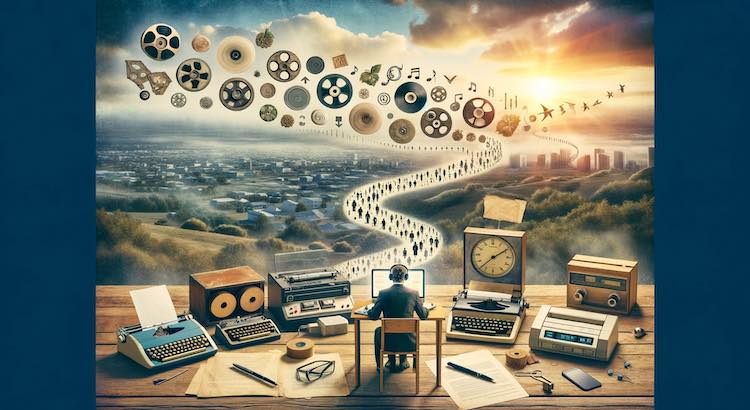The Evolution of Medical Transcription: From Tape to Digital Platforms
Medical transcription plays a vital role in healthcare. Over the decades, it has evolved from tape-based systems to secure digital platforms. This shift has improved accuracy, efficiency, and patient care.
The Early Days of Medical Transcription
Tape-Based Systems
In the mid-20th century, doctors started using tape recorders to capture patient notes. This was a breakthrough for several reasons:
- Allowed longer and more detailed dictations
- Freed doctors from handwriting notes
- Made documentation easier to store and share
Still, the tape system had downsides:
- Tapes could be damaged, lost, or worn out
- Quality of audio decreased over time
- Records were not always easy to access or share
Challenges with Tape-Based Systems
Doctors and transcriptionists worked with physical tapes, which posed real risks. If a tape was lost, sensitive patient data could also be lost.
The Move to Digital Medical Transcription
Benefits of Digital Platforms
The introduction of digital technology changed medical transcription. Digital recorders and computers replaced tapes, offering many benefits:
- Clearer sound quality for easier transcription
- Easy sharing of files via secure platforms
- Safe data backups and encryption for security
- Faster turnaround times for medical reports
Digital files also made it much harder for information to be lost, misplaced, or damaged.
Statistics on Digital Adoption
By 2022, over 85% of healthcare facilities used digital record-keeping and transcription (HIMSS, 2022). This improvement contributed to better documentation and patient care.
The Critical Role of Human Transcriptionists
Even as technology gets better, human transcriptionists remain essential. Advanced software and automated methods can help, but they have limits. Machines often struggle with:
- Complex medical vocabulary
- Doctor accents and speaking styles
- Understanding context and correcting errors
Skilled transcriptionists provide these vital services:
- Deciphering difficult accents and jargon
- Ensuring the highest level of accuracy
- Maintaining patient privacy and confidentiality
For reliable results, leading professionals turn to experienced teams like those at
GoTranscript’s transcription services.
How GoTranscript Maintains Quality
GoTranscript uses strict quality checks and experienced staff. Customers benefit from:
- Manual review to catch errors missed by AI
- Deep knowledge of medical terminology
- Fast, secure file handling every step of the way
Security and Confidentiality in Digital Transcription
Digital files must be protected. Data breaches in healthcare can harm patients and cost millions in fines (HIPAA Journal, 2023). GoTranscript tackles security concerns by:
- Using strong encryption for data protection
- Following HIPAA and other health standards
- Securing file transfers and storage
These steps help doctors and patients trust that their personal data stays safe.
Cost and Accessibility Improvements
Digital solutions have also lowered transcription costs. Automated tools and efficient platforms have reduced turnaround times by up to 60% since 2019 (MarketWatch, 2021).
For professionals concerned about price, GoTranscript offers
affordable transcription pricing and clear cost options. Clients can easily
order transcription services or
order captions online.
The Impact of Medical Transcription on Healthcare
How Digital Transcription Improves Patient Care
Enhanced documentation directly benefits healthcare:
- Doctors spend less time on paperwork and more on patients
- Medical histories are easy to retrieve and update
- Cooperation between care teams is smoother
- Turnaround for important reports is much quicker
Accurate records lead to better, safer care and improved outcomes.
The Role of Automation and AI
Automatic transcription and
AI transcription subscription tools offer extra speed and cost savings. However, quality assurance through
transcription proofreading services remains crucial. Human reviewers catch mistakes, especially when dealing with complex cases or unclear audio.
The Future of Medical Transcription
Ongoing Innovation
Medical transcription continues to evolve. Some trends and tools shaping the future include:
- Greater use of speech-to-text AI in basic note-taking
- Instant syncing with electronic health records (EHRs)
- Faster, more reliable communication for healthcare teams
- New tools such as text translation services and audio translation service for diverse patient groups
Even with these advancements, human skills will stay crucial for accuracy, context, and privacy.
Conclusion: GoTranscript Leads the Way in Medical Transcription
The journey from tape to digital has changed how healthcare handles documentation forever. GoTranscript stands out by offering secure, accurate, and human-driven
transcription services, as well as options for
automated transcription and
AI transcription.
From cost-effective
transcription pricing to full-scale
closed caption services and
subtitling services, GoTranscript supports every step of your information workflow. If your medical practice wants the best in modern transcription, GoTranscript’s solutions are designed to help you work smarter and deliver better care.



















 Verified Order
Verified Order